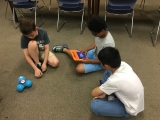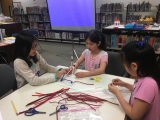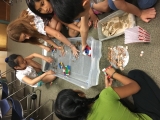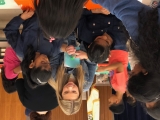-
Category 2
Selected in 2019
-
Grades: k - 4
School Setting: urban
Town Population: 92,271
Student Enrollment: 550
Student Demographics:
Black/African American: 13.5%
Teacher/Student Ratio: 1:12.2
White/Caucasian: 28.7%
Hispanic: 10.6%
Hawaiian/Pacific Islander: 1.1%
Asian: 44.8%
Native American: 0%
Other: 1.3%
% Reduced Lunch: 40%
% ELL Learners: 56%
Founded: 1998 -
PRINCIPAL:
Nicholas Ahearn -
CONTACT:
200 Moody Street
Quincy, MA 02169
617-839-7012
nicholasahearn@quincypublicschools.com
- Describe specific programs in place to ensure that families are involved in the success of your school and students.
- At the Marshall we run various parent engagement opportunities throughout our school year. Along with an incredibly active and supportive Parent Teacher Organization, we offer various parent engagement opportunities throughout the school year. Events include information nights regarding curriculum and assessment practices, but also events like One School One Book Literacy Night, Math Mania and Passport to International Night. Events like the ones he have work to both bring families into our building, but also to support building relationships with our families which is the cornerstone to the success that we see in our school.
- Describe the most successful activity your school has initiated to strengthen ties to your community.
- At the Clifford H. Marshall School, outreach to our families is at the cornerstone of our success. We have built a strong connection with our P.T.O. offering family educational opportunities including programming on curriculum, assessment, health and wellness and our PBIS model. Along with these events, we have also held One School One Book Literacy Night, Pasta Supper, Math Mania and our Passport to International Night. These events that bring our families into our school help support a strong home to school connection.
- Describe your philosophy of school change or improvement.
- School change needs to be done thoughtfully and should be driven by specific data with clear expectations and a clear outcome. The entire Marshall staff has been committed to positive change in the school and has worked through the S.M.A.R.T. Goal process to create clear and explicit action steps which drive our school improvement plan. Periodically during the school year we
- What are your school’s top two goals for the next year?
-
1) During the 2019-2020 school year, students in grades 3-4 at the Clifford Marshall School will show evidence of achievement in English language arts/ Mathematics as measured by an increase of 1.2 scaled score points in the All Students Average Composite Scaled Score
Throughout the 2019-2020 school year, each grade level and vertical team will address each of the Anchor Standards of the MA Curriculum Frameworks for ELA by working collaboratively to:
■ Develop standards based lessons that meet the needs of all learners.
■ Work collaboratively with Literacy, ELE and Special Education teachers differentiate instruction appropriately
2) During the 2019-2020 school year, the Clifford Marshall Elementary School will focus on supporting the social and emotional health and wellness of students by using strengths based framework to implement whole school cultural activities and a social skills curriculum for 100% of the school population along with collaboration opportunities with classroom teachers and small social groups as needed. - What is the single most important factor in the success of your school that others could replicate?
- For each and every student at the Marshall School, we focus on academic and also social and emotional growth. This growth starts by understanding our students both from an educational standpoint, but also by building strong relationships with our families. It is through these connections with our families that we are able to realize the greatest amount of growth. Knowing our students so well allows us to support them with a tiered model of support through our academic model and also through our PBIS model.
- Describe the program or initiative that has had the greatest positive effect on student achievement, including closing achievement or opportunity gaps, if applicable.
- The Marshall School has worked for the past five years to implement a Positive Behavioral Intervention Support (PBIS) model at our school. We have set explicit expectations for our 3 "R" (Respectful, Responsible and Ready) behavior throughout the building and have full buy-in from all stakeholders including our staff, students and families. This model includes weekly star student celebrations, monthly character trait assemblies, classroom lessons and a tiered model of support in our building.
- Explain how ESEA federal funds are used to support your improvement efforts.
- ESEA funds are used in multiple ways to promote success here for our students. Beyond supporting math interventionists positions at the Marshall School, funds are used to support high quality professional development related to the writers workshop model. Funds are also used to support parent engagement opportunities as well as extended day programming that runs afterschool and throughout summer months to support student learning throughout the entire year.
- Identify the critical professional development activities you use to improve teaching and student learning.
- Over several years, staff have been provided strong professional development in several areas. One aspect that has specifically impacted student achievement has been work to strengthen Close Reading strategies in grades 2-4. All staff have undergone SEI training as well to better support our large number of EL and FEL students.
- Describe how data is used to improve student achievement and inform decision making.
-
Data is a big part of the decision making process at the Marshall School. Periodically throughout the year we check in on student learning with Integrated Learning Teams (ILTs) comprised of grade level classroom teachers, EL ( English Learner staff) and interventionists who use benchmark data to chart both individual student progress and also grade level trends.
All of our staff also work to develop common formative assessments to measure ongoing progress and utilize formative and summative assessment data to improve instructional practices and develop appropriate intervention strategies when necessary. Centers have been designed to allow for differentiation within the classrooms to be able to meet the individual learning needs of each of our students. - Describe your school culture and explain changes you’ve taken to improve it.
- The Clifford Marshall School is K-4 elementary school located in Quincy, Massachusetts with approximately 550 students. Due to high churn rate in our school we welcome new students into our school regularly, and our hope is to quickly identify their academic needs, but also work to build a connection with the student's family. Our staff works incredibly hard to foster and grow these connections and by having open lines of communication, we are able to better understand the needs of all of our learners. Our goal is to offer surround care to support our students and families and we have a staff committed to academic as well as emotional growth from all of our students.
-
Category 2
Selected in 2019
-
Grades: k - 4
School Setting: urban
Town Population: 92,271
Student Enrollment: 550
Student Demographics:
Black/African American: 13.5%
Teacher/Student Ratio: 1:12.2
White/Caucasian: 28.7%
Hispanic: 10.6%
Hawaiian/Pacific Islander: 1.1%
Asian: 44.8%
Native American: 0%
Other: 1.3%
% Reduced Lunch: 40%
% ELL Learners: 56%
Founded: 1998 -
PRINCIPAL:
Nicholas Ahearn -
CONTACT:
200 Moody Street
Quincy, MA 02169
617-839-7012
nicholasahearn@quincypublicschools.com







